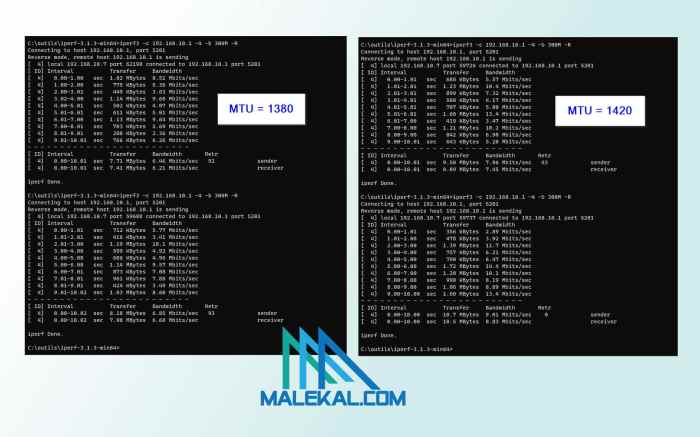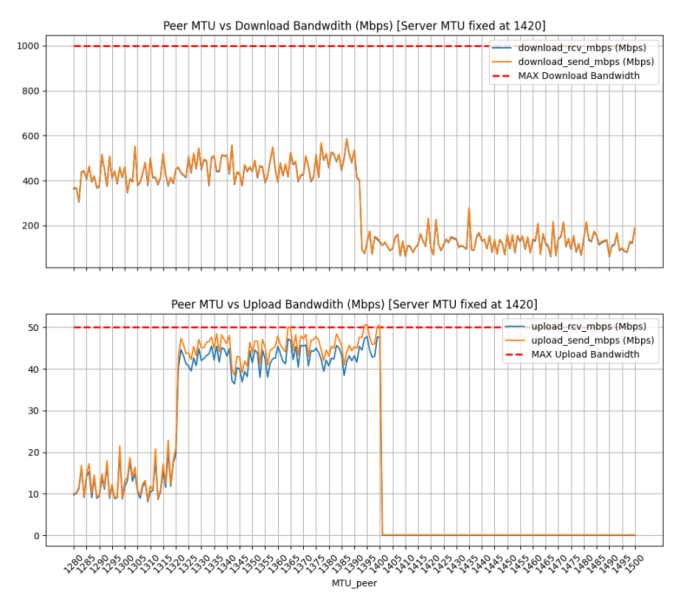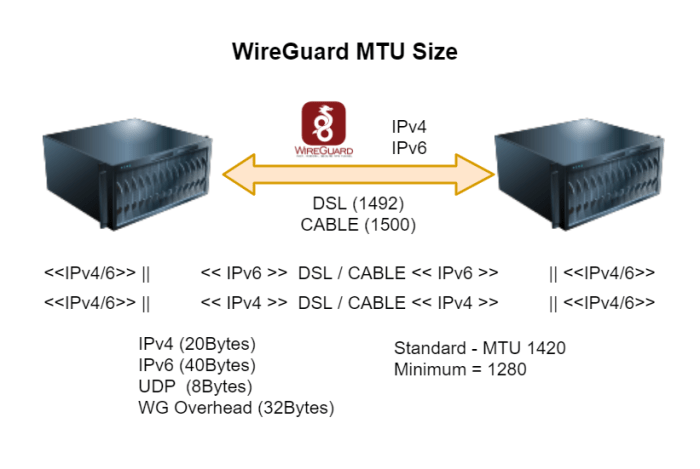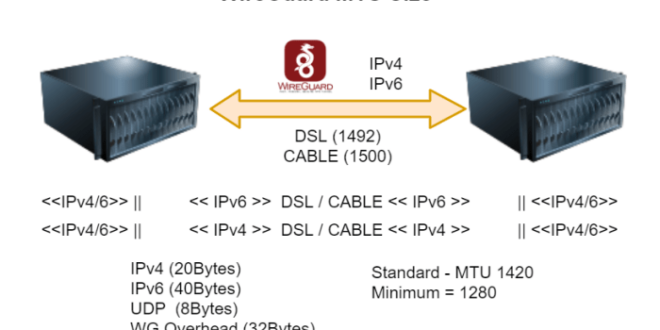In the realm of networking, understanding the intricacies of Maximum Transmission Unit (MTU) is crucial for maximizing network efficiency. WireGuard, a cutting-edge VPN protocol, offers granular control over MTU, allowing users to tailor their network performance to specific requirements. This comprehensive guide will delve into the world of WireGuard MTU size, empowering you to optimize your network like never before.
As we explore the concepts of MTU and its role in WireGuard, we will uncover the benefits of adjusting MTU size, the methods to do so, and common MTU sizes for various network environments. We will also tackle troubleshooting techniques, the impact of MTU size on fragmentation and security, and best practices for optimizing MTU size in different WireGuard implementations.
By the end of this guide, you will possess a thorough understanding of WireGuard MTU size, enabling you to unleash the full potential of your network.
WireGuard MTU Size Definition
In networking, Maximum Transmission Unit (MTU) refers to the largest possible size of a data packet that can be transmitted over a specific network interface.
In WireGuard, MTU plays a crucial role in determining the efficiency and performance of the VPN connection. It defines the maximum size of packets that can be sent and received through the WireGuard tunnel.
Role of MTU in WireGuard
- Packet Fragmentation: When the MTU size is set too low, large packets may need to be fragmented into smaller segments to be transmitted. This fragmentation process can introduce additional overhead and reduce network performance.
- Network Performance: An optimal MTU size allows for the transmission of larger packets, reducing the number of packets that need to be sent and improving overall network throughput.
- Compatibility: Ensuring that the MTU size matches the MTU of the underlying network is essential for maintaining compatibility and preventing packet loss or errors.
Default MTU Size in WireGuard

WireGuard sets a default MTU (Maximum Transmission Unit) size to optimize network performance and ensure efficient data transfer. This default value is carefully chosen to balance various factors, such as network overhead, fragmentation, and compatibility with different network environments.
The default MTU size in WireGuard is 1420 bytes. This value is commonly used in Ethernet networks, which typically have an MTU size of 1500 bytes. However, WireGuard subtracts 80 bytes for its own encapsulation overhead, resulting in a default MTU size of 1420 bytes.
Benefits of Adjusting MTU Size

Adjusting the MTU size in WireGuard can provide several benefits for network performance:
Improved Performance: Optimizing the MTU size allows WireGuard to send and receive data packets that are the maximum size that the network can handle. This reduces packet fragmentation, which can occur when packets are larger than the MTU, and improves overall network efficiency.
Increased Bandwidth Utilization
By reducing packet fragmentation, adjusting the MTU size can increase bandwidth utilization. When packets are fragmented, they require additional overhead for each fragment, which can consume valuable bandwidth. By sending larger packets, WireGuard can reduce this overhead and improve the effective bandwidth available for data transfer.
Reduced Latency
Packet fragmentation can also introduce latency into the network. When a packet is fragmented, each fragment must be processed individually, which can delay the delivery of the entire packet. Optimizing the MTU size reduces fragmentation and improves latency, resulting in faster response times for applications and services.
Methods to Adjust MTU Size
Adjusting the MTU size in WireGuard can be done through various methods, depending on the operating system and configuration settings.
Common approaches include modifying the WireGuard configuration file or using command-line utilities.
Adjusting MTU Size in the Configuration File
In the WireGuard configuration file, the MTU size can be set using the mtu parameter. For instance:
[Interface] Address = 10.0.0.1/24 ListenPort = 51820 PrivateKey = /path/to/privatekey MTU = 1420
Adjusting MTU Size Using Command-Line Utilities
On Linux systems, the wg set command can be used to modify the MTU size of an existing WireGuard interface.
For example:
wg set wg0 mtu 1420
On Windows systems, the netsh command can be used to set the MTU size of a WireGuard interface. For instance:
netsh interface wg set interface "WireGuard Interface" mtu=1420
Common MTU Sizes for Different Network Environments
MTU sizes vary depending on the network environment. Here are some common MTU sizes used in different scenarios:
LAN (Local Area Network)
LANs typically use an MTU of 1500 bytes. This is the default MTU size for Ethernet networks and provides a good balance between performance and compatibility.
WAN (Wide Area Network)
WANs often have a lower MTU size than LANs due to the higher latency and packet loss that can occur over long distances. Common MTU sizes for WANs include 1492 bytes (for PPPoE connections) and 1472 bytes (for DSL connections).
VPNs (Virtual Private Networks)
VPNs typically use an MTU of 1400 bytes or 1364 bytes. This is because VPNs add an overhead to each packet, which reduces the effective MTU size.
Determining the Appropriate MTU Size
To determine the appropriate MTU size for a specific network, you can use the following methods:
– -*Ping Test: Send ping packets with the “-s” option to specify the packet size. Gradually increase the packet size until you start seeing packet fragmentation. The maximum packet size that doesn’t fragment is the appropriate MTU size.
– -*Traceroute: Use the “traceroute” command to trace the path of packets between two hosts. The MTU size will be reported in the output. – -*MTU Discovery: Some operating systems and network devices support MTU discovery, which automatically adjusts the MTU size based on the network conditions.
Troubleshooting MTU Size Issues
Identifying and resolving MTU size issues in WireGuard is crucial for maintaining optimal network performance. Common issues include:
– Packet fragmentation: Occurs when packets exceed the MTU size, resulting in performance degradation. – Packet loss: Excessive fragmentation can lead to packet loss, affecting network connectivity.
To diagnose these issues, consider the following steps:
Inspecting Packet Sizes
Analyze network traffic using tools like Wireshark or tcpdump to monitor packet sizes. If packets consistently exceed the MTU size, it indicates a potential issue.
Adjusting MTU Size
If packet fragmentation is detected, adjust the MTU size to a lower value. Start by reducing it by 28 bytes (the size of the WireGuard header) and incrementally lower it until fragmentation is resolved.
Testing Network Connectivity
After adjusting the MTU size, perform network connectivity tests to ensure the issue is resolved. Monitor performance and packet sizes to verify that the network is operating efficiently.
MTU Size and Fragmentation

The Maximum Transmission Unit (MTU) size determines the largest packet size that can be transmitted over a network. When a packet exceeds the MTU size, it is fragmented into smaller packets that can be transmitted over the network. This process, known as fragmentation, can introduce additional overhead and latency into the network.
Impact of Fragmentation on Network Performance
Fragmentation can negatively impact network performance by:
- Increasing overhead: Each fragmented packet requires its own header, which increases the overall size of the transmission.
- Introducing latency: The fragmentation and reassembly process can introduce additional delay into the network.
- Reducing efficiency: Fragmented packets may not be able to be transmitted at the same rate as larger packets, leading to reduced network efficiency.
MTU Size and Security
Adjusting the MTU size in WireGuard can have potential security implications. A smaller MTU size can increase the number of fragments in a packet, which can make it more susceptible to fragmentation attacks. Attackers can exploit these fragments to gain unauthorized access to the network or launch denial-of-service attacks.To
mitigate these risks, it is important to use a MTU size that is appropriate for the network environment. It is also important to use strong encryption and authentication mechanisms to protect the data transmitted over the network.
[detailed content here]MTU Size in Different WireGuard Implementations
Different WireGuard implementations on various operating systems may handle MTU size differently. Let’s explore these variations:
Linux
On Linux, WireGuard generally uses a default MTU size of 1420 bytes, which is the recommended value for most network environments. However, you can manually adjust the MTU size to optimize performance for specific scenarios.
Windows
WireGuard for Windows also uses a default MTU size of 1420 bytes. However, there is a known issue where the MTU size may be automatically reduced to 1350 bytes on some Windows systems. To resolve this, you can manually set the MTU size to the desired value using the configuration file or command-line options.
macOS
On macOS, WireGuard uses a default MTU size of 1500 bytes, which is slightly higher than the typical recommendation for most networks. This larger MTU size can potentially improve performance on certain network configurations, but it may also increase the risk of fragmentation if the underlying network does not support it.
Best Practices for MTU Size Optimization
Optimizing the MTU size in WireGuard is crucial for achieving optimal network performance. By adhering to these best practices, you can ensure efficient data transmission and minimize network issues.
One of the key best practices is to match the MTU size to the underlying network infrastructure. For example, if your network uses Ethernet connections with a default MTU of 1500 bytes, it’s recommended to set the WireGuard MTU to 1500 bytes as well.
This ensures that packets are not fragmented unnecessarily, which can introduce performance overhead.
Ping Test
To determine the optimal MTU size for your network, it’s advisable to perform a ping test between two WireGuard peers. Start with a large MTU size (e.g., 1500 bytes) and gradually decrease it until you find the value that provides the best ping response times.
This method helps identify the maximum MTU size that your network can handle without experiencing fragmentation.
Monitoring Network Traffic
Additionally, monitoring network traffic can provide valuable insights into the impact of MTU size on performance. If you notice excessive fragmentation or packet loss, it may indicate that the MTU size is not optimal. Adjusting the MTU size accordingly can help resolve these issues and improve network stability.
Avoid Fragmentation
As a general rule, it’s best to avoid fragmentation whenever possible. Fragmentation occurs when packets exceed the MTU size and need to be broken into smaller fragments. This process can introduce delays and reduce network performance. By setting the MTU size appropriately, you can minimize fragmentation and ensure smooth data transmission.
Outcome Summary
In conclusion, mastering WireGuard MTU size is a key aspect of optimizing your network performance. By understanding the concepts, benefits, and methods of adjusting MTU size, you can tailor your network to specific requirements, minimize fragmentation, enhance security, and achieve optimal performance.
Whether you are a network administrator or an individual seeking to enhance your internet experience, this guide has equipped you with the knowledge and tools to harness the power of WireGuard MTU size. Embrace the potential and unlock the full capabilities of your network today!
